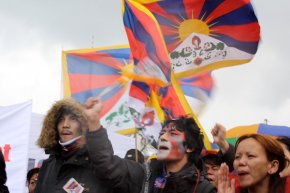Difference between revisions of "Tibet"
| Line 2: | Line 2: | ||
[[File:Tibet.jpg|400x200px|framed|left]] | [[File:Tibet.jpg|400x200px|framed|left]] | ||
| − | The People's Republic of China systematically took over Tibet as a means of expansion, despite the fact that Tibet was an autonymous state with a unique culture, language, and religious beliefs. | + | The People's Republic of China systematically took over Tibet as a means of expansion, despite the fact that Tibet was an autonymous state with a unique [[Culture|culture]], language, and religious beliefs. |
In 1949, the Chinese invaded and colonised Tibet, and from 1959 to 1976, the Chinese forcibly repressed any uprising, and began to perform mass arrests and set up labour camps for Tibetans. It was also during this time that all traces of Tibetan culture and religion were destroyed. It is estimated that between 1 and 1.5 million Tibetans were killed over this period of time, either being executed, starved, tortured, committing suicide, or in combat. | In 1949, the Chinese invaded and colonised Tibet, and from 1959 to 1976, the Chinese forcibly repressed any uprising, and began to perform mass arrests and set up labour camps for Tibetans. It was also during this time that all traces of Tibetan culture and religion were destroyed. It is estimated that between 1 and 1.5 million Tibetans were killed over this period of time, either being executed, starved, tortured, committing suicide, or in combat. | ||
[[Category:Human Rights & Global Peace]] | [[Category:Human Rights & Global Peace]] | ||
Latest revision as of 13:06, 1 April 2014
The People's Republic of China systematically took over Tibet as a means of expansion, despite the fact that Tibet was an autonymous state with a unique culture, language, and religious beliefs. In 1949, the Chinese invaded and colonised Tibet, and from 1959 to 1976, the Chinese forcibly repressed any uprising, and began to perform mass arrests and set up labour camps for Tibetans. It was also during this time that all traces of Tibetan culture and religion were destroyed. It is estimated that between 1 and 1.5 million Tibetans were killed over this period of time, either being executed, starved, tortured, committing suicide, or in combat.
